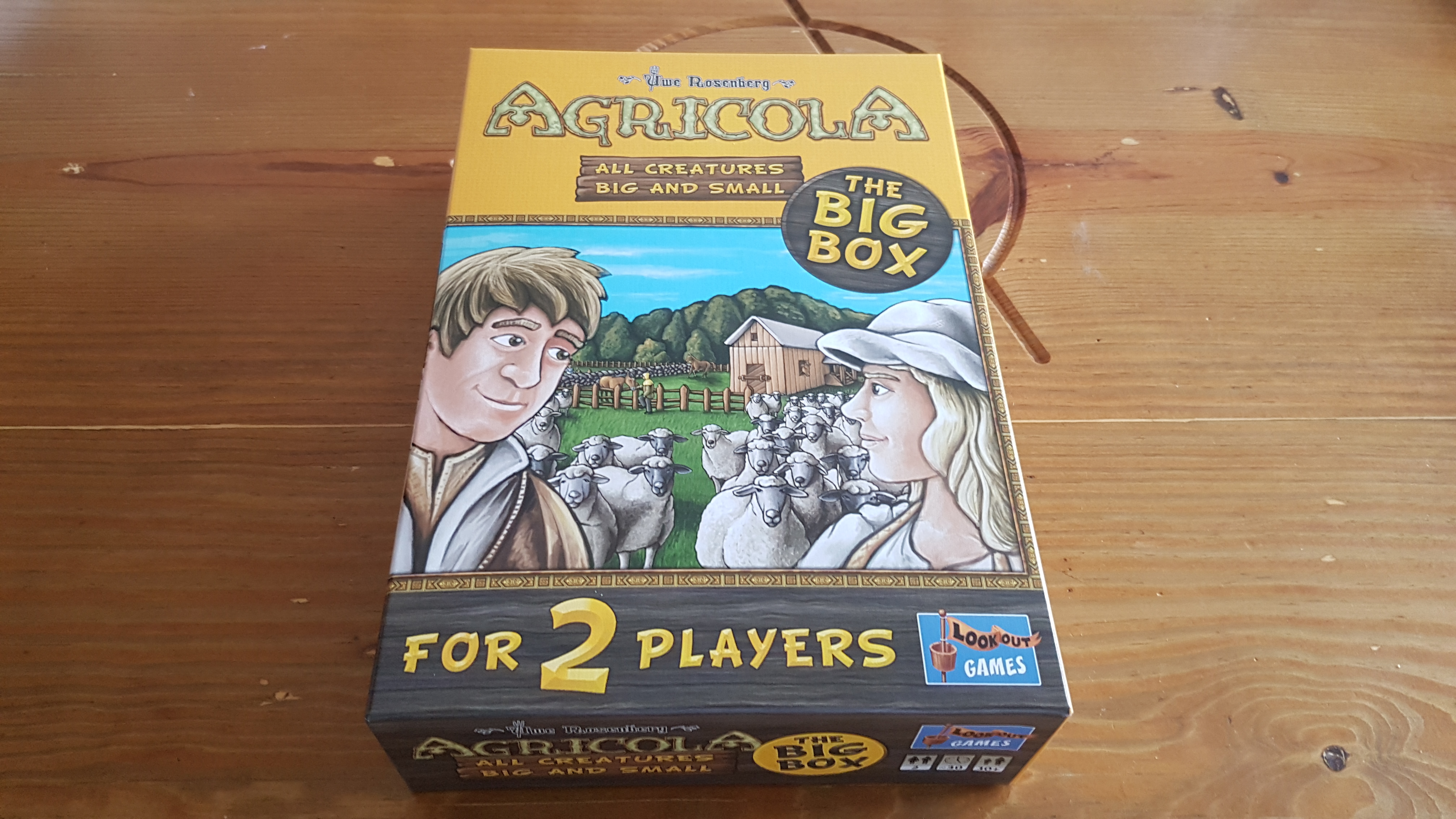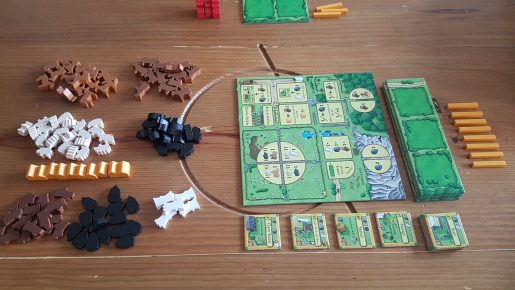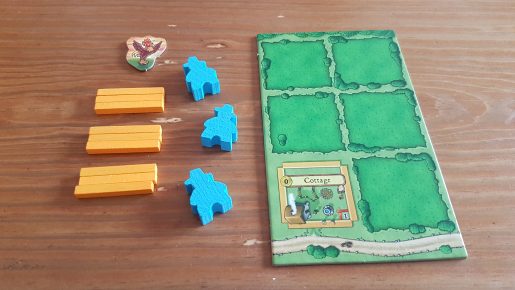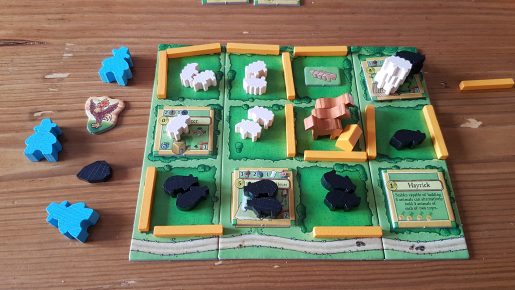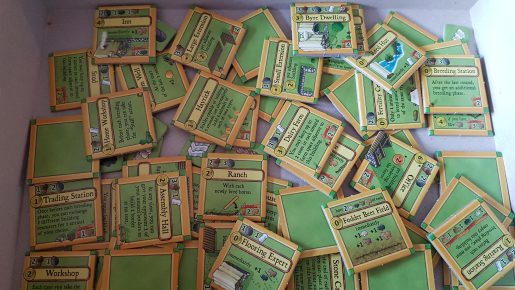Agricola All Creatures Big & Small Big Box is the brand new printing of the farm themed, 2-player only, worker placement board game from Lookout Games. This big box includes both inventively named expansions: More Buildings Big and Small and Even More Buildings Big and Small. Designed by Uwe Rosenberg the game sees players take up the role of farm owners for around 30 minutes. Starting out with a small plot of land farmers will get to make pens, gain animals, set some free, expand their farm and more. However, is this a farming experience that players will be on the fence about? Let’s find out!
To make sense of the actions and general gameplay, Agricola All Creatures Big & Small is one of those games where knowing what the end game might look like and how to score is key. Points are awarded over 4 categories: number of animals (4 types: sheep, cows, pigs and horses), bonuses per animal type, full expansion boards and buildings. In terms of bonus points it is actually possible to lose points by having 3 or fewer of each of the 4 animal types, with bonus points awarded at different rates for each animal. Expansion boards score if completely utilized, be it by a fenced area or buildings; while buildings detail how many points they are worth. So, lots of animals in fenced areas, with a building or two, is the general aim.
What do farmers start with? Both players start with a 3 x 2 field farm with one square featuring a cottage, 3 workers and 9 fence pieces. The game takes place over 8 rounds, each consisting of 4 phases: refill, work, home and breeding. Refill is effectively a setup phase, which adds resources to a number of the action spaces. There are significantly more spaces than the combined 6 workers that the two players have, so a number will go unused from one round to the next.
Some action spaces feature an arrow symbol that means resources are added each round, no matter what has happened, making it more beneficial to take the action in subsequent rounds. The best example of this is expand which a fence piece is added to each round, potentially building up over time. This is significant as there are only an addition 8 fences, so this can be used as a round countdown tracker. Other action slots are refilled no matter what but with a secondary resource type if the action was unused. The Horse space for example has a basic return of 1 horse but if unused in a round has a sheep, instead of an additional horse, added to sweeten the deal.
The work phase is where the majority of the game takes place, with a choice of 17 spaces: Agricola All Creatures Big & Small certainly offers players plenty of choice. Gamers will constantly get the feeling of there being lots to do but with not enough time to do everything. Therefore, it can be key to work towards small goals each round for the first few plays before forming grander plans. Actions include: claiming resources (there are three types: wood, stone and reed); taking an expansion board and available fence pieces; taking an animal; placing fences onto your farm; building a feeding trough or constructing a building.
There are multiple ways to get each resource so there is always a chance to get some of a resource you need. Wood is potentially the most interesting, with the claim 1 wood action space, which builds up over time via refilling, also including the starting player marker. Note, this is the only way the starting player will change and this results infrequent starting player changes. So you have some resources, what’s stopping you from grabbing those point scoring animals for your farm? Well animals will run away if not fenced in.
Fences and buildings, which have their four sides fenced, are where the planning aspect of Agricola All Creatures Big & Small truly comes into play. The starting farm is 3 x 2 fields, with the cottage that adds walls; not exactly fit for tonnes of animals. By default, by fencing around a 1 x 1 area you can house two animals of the same type. As logic would have it, a fenced field of 1 x 2 can house 4 animals of the same type. Players can via different action spaces build fences, and additional ones by paying resources, and doing this ahead of time helps players to not turn down animals or set others free. The issue is once placed fences cannot be moved.
Getting an expansion board that adds 1 x 3 fields of land to your farm can significantly help out, though feeding troughs are also a viable option. Each individual field can store one of these troughs and it doubles the holding capacity of the entire fenced of area it sits in, though the limitation of animal type remains. For example, a 2 x 2 field can normally hold 8 animals but with only a single trough that would be doubled to 16! This can see huge amounts of animals happily fill an area, altering the farm to be more battery farm-like than free range.
The home phase is a short and slightly uninspiring one, simply seeing workers returned to their owners. Breeding is the final phase, with players gaining a free animal of a type they have at least two of. Note, this is only one per animal type not per two animals that biological might tell you. Eight rounds of the 4 phases are played, with scoring determined at the very end; with ties won by whomever didn’t go first in the first round.
If there is one thing I’ll be eternally grateful to Agricola All Creatures Big & Small for is introducing the term sheeples into my vocabulary. Aside from the awesome word all of the wooden animals are great at giving players’ farms that visual pop, and the game a tactile feel that simple counters or tokens couldn’t have done, matching the fences. The only negative is the colouring used, with the browns of the horses and cows being rather similar. They are similar enough that at a glance they can be mistaken. It begs the question why the black pigs aren’t pink and the cows black instead of brown. Making sure the animal types are separated in piles before play eases any potential issue, it’s just something this new version could have easily addressed.
The tile design is clear and clean, allowing the visual appeal of the game not to be too hindered, whilst offering all relevant information. This is impressive as the information includes; the resource cost, the points awarded, how many animals it can store and if it comes with an ability. The base game includes 5 types for players to choose from and realistically are all you need for the first couple of plays. Getting to grips with the balance of the rest of the game, from the amount of rounds to how scoring works is slightly easier with just the default buildings, which helpfully come with a yellow backing to help them stand out.
These starting buildings include: five Stall/Stable tiles which can be built to house animals, and upgraded to hold more; an open stable tile, which is a special upgrade to a stall that gifts a horse or cow whilst upping the animal limit and points of the building; a half timber house that upgrades your cottage to offer 5 victory points; a shelter which lets the owner instantly take a single animal of any type; and storage which scores the player points based upon their resources at the end of the game. Once built building tiles, aside from if the open stable comes into play, do not go back into the general pool, so sometimes there can be competition over whom can get a specific building first.
Not just one but two expansions are included in this big box release: More Buildings Big and Small and Even More Buildings Big and Small. Both expansions introduce a whopping 27 new unique building tiles. The number might sound a lot and look in the box a tad daunting, however, only a maximum of 12 tiles are ever put in play in an expert game; even the advanced variant only uses 8! These add in new abilities, come with different costs and victory points, instilling variation into the game with the pool of special buildings most likely never being identical. Unless you do end up playing the game over 100 times, however, the sheer amount might be classed as overkill. One tile does stand out slightly, as an oddity. The shelter tile uses a different wood symbol from the rest of the tiles, a somewhat odd oversight from the reproduction. For a new player this can be off-putting if it isn’t pointed out in advance, since everywhere else in the game a consistent symbol is utilized for wood.
Agricola All Creatures Big & Small is a game where each decision matters, with players left having to work out what element they’ll neglect due to only having limited actions. Constantly, I was left “needing” that one extra action or round that would have seen my plans come to fruition. Do gamers need the full range of 54 expansion tiles? No, but the special tile pool makes each and every game a little different, without increasing the difficulty of the game. For all of the game to fit into 30 minutes and on top of that all the additional content in the box for the price, Agricola All Creatures Big & Small could be the 2-player experience you’re looking for.
[Editor’s Note: Agricola All Creatures Big & Small was provided to us by Asmodee UK for review purposes. The game is currently available on 365 Games for £23.99. It is also available from local UK board game stores, find your local store here]

